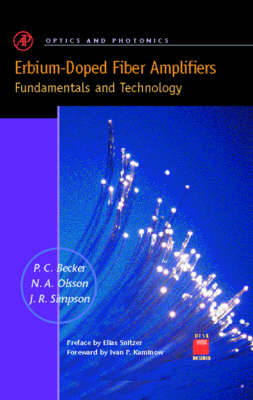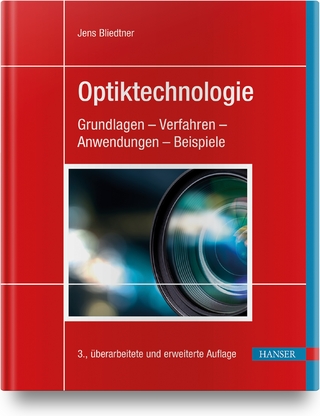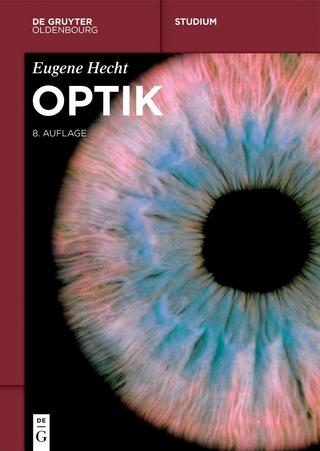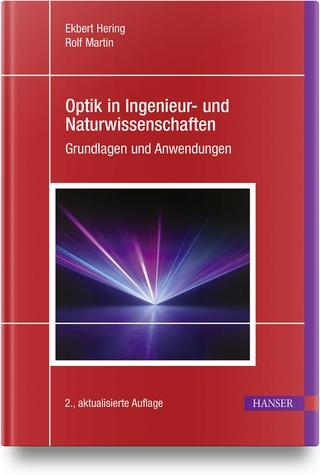
Erbium-doped Fiber Amplifiers
Academic Press Inc (Verlag)
978-0-12-084590-3 (ISBN)
- Titel ist leider vergriffen;
keine Neuauflage - Artikel merken
"Erbium Fiber Amplifiers" is a comprehensive introduction to the increasingly important topic of optical amplification. Written by three Bell Labs pioneers, the book stresses the importance of the interrelation of materials properties, optical properties, and systems aspects of optical fiber amplifiers. The floppy disk included with the book contains a PC based educational version of the sophisticated commercial amplifier simulation package OASIX (sold by the Specialty Fiber Group of Lucent Technologies). This powerful numerical simulation software allows one to simulate the performance of a real erbium fiber amplifier, and obtain its properties such as signal gain and noise generated. Several parameter sets are included, each of which represents a commercially available type of erbium doped fiber used in different kinds of amplifiers (e.g. preamplifiers and power amplifiers). The user can vary, via Windows based input screens, various amplifier characteristics such as fiber length, pump power, signal power, and additional signals. The output is saved in a file which can be read by any spreadsheet or plotting package for graphical representation of the results.
The software allows the reader to explore on his or her own the concepts of amplifier performance discussed in the book, and gain a more intuitive and interactive educational experience leading to a richer understanding of erbium-doped fiber amplifiers and their applications. It includes a software disk with a PC-based amplifier simulation tool derived from a sophisticated commercial package (OASIX), which allows the reader to gain an interactive educational experience using parameters for commercially available erbium-doped fibers. It explains the theory of noise in optically amplified systems in an intuitive way. The book contains a discussion of components used in amplifier fabrication and of the attendant technologies used in real systems. The book provides basic tools for amplifier design as well as systems engineering, including the latest developments in WDM and soliton systems. The book discusses the fundamentals of rare earth ions for the reader desiring more depth in the topic.
The book is for either the novice of experienced reader, and the chapters have links between them to allow the reader to understand the relationship between the amplifier characteristics, noise, and systems applications. The book also contains extensive references.
After doing his Ph.D. thesis on the luminescent properties of thulium at UC Berkeley, Philippe joined Bell Laboratories in 1986 where he contributed to the development of erbium doped fiber amplifiers. He has also done extensive research in the femtosecond laser field, and was a member of the Bell Labs research group which generated the world record shortest laser pulse. He was awarded the 1994 NASTS award for his contributions to the development of the erbium fiber amplifier. He is a member of the OSA and the IEEE. After a recent stint directing strategy for Lucent Technologies corporate strategy group, Philippe is now Business and Marketing Director for Lucent Technologies Advanced Lightwave Systems. Anders received his Ph.D. from Cornell in 1982, the joined Bell Laboratories where he became active in lightwave component research. He did pioneering work in WDM systems as well as in the development of semiconductor amplifiers and amplified transmission systems, from both a theoretical and experimental standpoint. Anders has been Chief Technical Officer of AT&Ts Optoelectronics Business Unit, and is now Executive Director of Advanced Lightwave Systems at Lucent Technologies. Anders is a Fellow of the OSA and a senior member of the IEEE. Jay has a Ph.D. from Rutgers University, studying defects in glass structure. He has spent 25 years with Bell Laboratories where he became a Distinguished Member of Staff. Jay was an early pioneer in many aspects of specialty fiber fabrication (polarization maintaining fiber, rare earth doped fibers). Jay is a member of the OSA. He is currently with Lucent Technologies Advanced Technologies division. Jay holds 13 patents and over 80 publications in the field of optical fibers.
INTRODUCTION 1.1 Long Haul Fiber Networks 1.2 Historical Development of Erbium-Doped Fiber Amplifiers 1.3 From Glass to Systems 2 OPTICAL FIBER FABRICATION 2.1 Introduction 2.2 Conventional Communication Fiber 2.3 Rare Earth Doped Fibers 2.4 Pump-Signal Interaction Methods 2.5 Compositions 2.6 Physical Properties 3 COMPONENTS AND INTEGRATION 3.1 Introduction 3.2 Fiber Connectors 3.3 Fusion Splicing 3.4 Pump and Signal Combiners 3.5 Isolators 3.6 Circulators 3.7 Filters 3.8 Fiber Gratings 3.9 Signal Multiplexers and Demultiplexers 3.10 Signal Add/Drop Components 3.11 Dispersion Compensation Components 3.12 Integrated Components 3.13 Pump Lasers 4 RARE EARTH IONS--INTRODUCTORY SURVEY 4.1 Introduction 4.2 Atomic Physics of the Rare Earths 4.3 Optical Spectra of Rare Earth Ions 4.4 Fundamental Properties 4.5 Spectroscopy of the Er3 Ion 4.6 Er3 -Er3 Interaction Effects 5 ERBIUM-DOPED FIBER AMPLIFIERS--AMPLIFIER BASICS 5.1 Introduction 5.2 Amplification in Three-Level Systems 5.3 Reduction of the Three-Level System to the Two-Level System 5.4 Amplified Spontaneous Emission 5.5 Analytical Solutions to the Two-Level System 6 ERBIUM-DOPED FIBER AMPLIFIERS--MODELING AND COMPLEX EFFECTS 6.1 Introduction 6.2 Absorption and Emission Cross Sections 6.3 Gain and ASE Modeling 6.4 Amplifier Simulations 6.5 Transverse Mode Models--Erbium Confinement Effect 6.6 Excited State Absorption Effects 6.7 Er3 -Er3 Interaction Effects 7 OPTICAL AMPLIFIERS IN FIBER OPTIC COMMUNICATION SYSTEMS--THEORY 7.1 Introduction 7.2 Optical Noise: Device Aspects 7.3 Optical Noise: System Aspects 8 AMPLIFIER CHARACTERIZATION AND DESIGN ISSUES 8.1 Introduction 8.2 Basic Amplifier Measurement Techniques 8.3 Amplifier Design Issues 9 SYSTEM IMPLEMENTATIONS OF AMPLIFIERS 9.1 Introduction 9.2 System Demonstrations and Issues 9.3 Soliton Systems 10 FOUR LEVEL FIBER AMPLIFIERS FOR 13 MM AMPLIFICATION 10.1 Introduction 10.2 Pr3 -doped Fiber Amplifiers 10.3 Nd3 -doped Fiber Amplifiers Appendix Subject Index
| Erscheint lt. Verlag | 8.3.1999 |
|---|---|
| Reihe/Serie | Optics and Photonics |
| Zusatzinfo | b&w illustrations, index |
| Verlagsort | San Diego |
| Sprache | englisch |
| Maße | 235 x 159 mm |
| Gewicht | 835 g |
| Themenwelt | Naturwissenschaften ► Physik / Astronomie ► Optik |
| Technik ► Maschinenbau | |
| Technik ► Nachrichtentechnik | |
| ISBN-10 | 0-12-084590-3 / 0120845903 |
| ISBN-13 | 978-0-12-084590-3 / 9780120845903 |
| Zustand | Neuware |
| Haben Sie eine Frage zum Produkt? |
aus dem Bereich


